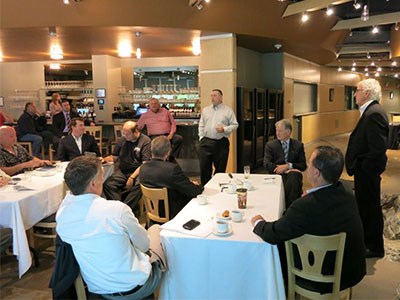The copper-nickel-PGM property being developed by Duluth Metals isn’t located in Northern Ontario.
You can’t even find it in Canada. But a recent Sudbury appearance by Duluth’s president and CEO, Vern Baker, attracted a packed house based on the potential it holds for Northern supply and service companies.
Located in Northern Minnesota along the north shore of Lake Superior, Baker predicts the Twin Metals Minnesota (TMM) complex (a joint venture with Chile’s Antofagasta plc) will become one of the world’s major mining districts over the next five to 10 years because of the massive potential tonnages and the types of ore to be found there.
“We have a huge opportunity just in the quantity of metal that’s available,” said Baker, who puts TMM on the same scale as some of the largest copper mines in South America. “It’s got some very distinct similarities to Sudbury and some very distinct differences.”
Duluth’s January 2013 NI 43-101 resource report indicates 13.6 billion pounds of copper, 4.4 billion pounds of nickel, 5.6 million ounces of platinum, 12.7 million ounces of palladium, and 3.1 million ounces of gold.
It infers another 11.9 billion pounds of copper, 4.1 billion pounds of nickel and 12.8 million ounces of total precious metals.
The company has spent $200 million on the project to date, and Baker estimates that could rise to between $1.5 billion and $2 billion.
Duluth sees the project going forward as an underground operation with production of 40,000 to 50,000 tonnes of ore per day to start. The grades aren’t huge compared to Sudbury, Baker said, but the large scale of production, at a cost of $12 to $18 per tonne depending on the chosen techniques, should still make it a worthwhile venture.
“We’re looking at costs of mining that are a fraction of what we do in many of the camps of North America right now, simply because of the cost and continuity and the ability to build systems that are completely repeatable,” he said.
Located near the Mesabi Iron Range, which has hosted active iron mining since 1883, the TMM complex is situated near four ports, railroads, power plants, a paved highway, and two technical colleges focused on developing tradespeople for the mining industry.
So what’s in it for Northern Ontario? With an estimated $600 to $700 million annual operating cost, most of it spent on supply buying, Baker suggested companies in Sudbury and across the North could use their mining expertise to leverage some supply and service contracts at TMM.
“That one project has the potential to generate hundreds of millions of dollars of supply purchases. Obviously, that’s something that this group here can help with in the future,” Baker said.
“Especially since the focus where we’re looking at is predominantly underground operations, there’s a specialization here in Sudbury underground that has been tremendous, and you guys probably carry as much knowledge of underground mining and its needs as there is anywhere in the world right here within your group.”
Duluth is particularly keen to explore new technologies to maintain efficiencies, and Baker praised local companies like Rail-Veyor, as well as research being done on underground ventilation systems, for using innovation in their approaches to mining.
Baker said the company is also interested in finding a customer for its product in the North, noting that CN is the primary rail provider in northern Minnesota, and Duluth is eager to work with them. “Looking at the transportation of concentrates, the single best outlet for us would be to ship it to Sudbury; putting it on CN and getting it here is probably the cheapest, most efficient option we would have for those concentrates,” Baker said.
“Whether we would have a potential customer here is another question, but looking worldwide, that would be our favoured location to go to.”
By this time next year, the company hopes to have released a full NI 43-101 prefeasibility resource report, followed by two years of permitting before construction gets underway. Once development begins, Duluth is hoping to reach a target of five to six km per month of development drifting.
Baker believes that past mining in the area will help smooth the way for permitting, noting that six new mining projects have been permitted in the last 10 years.
New legislation has been passed to speed up the EIS process, and there is strong bipartisan political support for mine development at the state and federal levels of government.
Baker said Duluth is also in the process of establishing a relationship with three small bands representing the Ojibwes of northern Minnesota.




